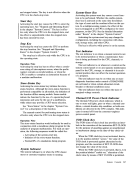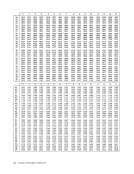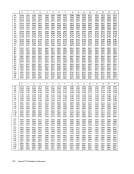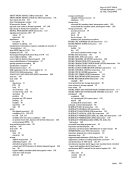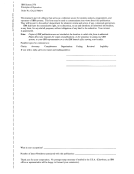Programming Note
If a device becomes not ready upon completion of a
command, the ending interruption condition can be
cleared by TESTI/O without generation of unit
check due to the not-ready state, but any subsequent
TESTI/O issued to the device causes a unit-check
indication.
In order that sense indications set in conjunction
with unit check are preserved by the device until
requested by a sense command, some devices inhibit
certain functions until a command other than testI/O or no-operation is received. Furthermore, any
command other than sense, testI/O, or no
operation causes the device to reset any sense in
formation. To avoid degradation of the device and
its control unit and to avoid inadvertent resetting of
the sense information, a sense command should be
issued immediately to any device signaling unit
check.Unit Exception Unit exception is caused when the I/O device de
tects a condition that usually does not occur.Unit exception includes conditions such as recognition of
a tape mark and does not necessarily indicate an
error. It has only one meaning for any particular
command and type of device.
The unit-exception conditioncal\ be generated
only when the device is executingan I/O operation,
or when the device is involved with some activity
associated with anI/O operation and the condition
is of immedicate significance to the program. If the
device detects during the initiation sequence that the
operation cannot be executed, unit exception is pre
sented to the channel and appears without channel
end, control unit end, or device end. Such unit sta
tus indicates that no action has been taken at the
device in response to the command. If the condition
precluding normal execution of the operation occurs
after the execution has been started, unit exception
is accompanied by channel end, control unit end, or
device end, depending on when!he condition was
detected. Any unusual conditions associated with an
operation, but detected after device end has been
cleared, are indicated by signaling unit exception
with attention.
A command does not cause unit exception when
the device responds to the command during the ini
tial selection with busy status.
Concluding an operation with the unit-exception
indication causes command chaining to be sup
pressed.
Channel Status Conditions
The following conditions are detected and indicated
by the channel. Except for the conditions caused by
equipment malfunctioning, they can occur only while
the subchannel is involved with the execution of anI/O operation.
Program-Controlled Interruption
The program-controlled interruption condition is
generated when the channel fetches a CCW with the
program-controlled interruption(PCl) flag on. The
interruption due to thePCI flag takes place as soon
as possible after the CCW takes control of the opera
tion but may be delayed an unpredictable amount of
time because of masking of the channel or other
activity in the system.
Detection of thePCI condition does not affect
the progress of theI/O operation.
Incorrect Length
Incorrect length occurs when the number of bytes
contained in the storage areas assigned for theI/O operation is not equal to the number of bytes re
quested or offered by theI/O device. Incorrect
length is indicated for one of the following
backward, or sense operation, the device attempted
to transfer one or more bytes to storage after the
assigned storage areas were filled. The extra bytes
have not been placed in main storage. The countin the CSW is zero.
Long Block on Output: During a write or control
operation the device requested one or more bytes
from the channel after the assigned main-storage
areas were exhausted. The count in the CSW is
zero.
Short Block on Input: The number of bytes trans
ferred during a read, read-backward, or sense opera
tion is insufficient to fill the storage areas assigned to
the operation. The count in the CSW is not zero.
Short Block on Output: The device terminated a
write or control operation before all information
contained in the assigned storage areas was trans
ferred to the device. The count in the CSW is not zero.
The incorrect-length indication is suppressed
when the current CCW has the SLI flag and does
not have the CD flag. The indication does not occur
for immediate operations and for operations rejected
during the initiation sequence.
Presence of the incorrect-length condition sup
presses command chaining unless the SLI flag in theInput/Output Operations 233
If a device becomes not ready upon completion of a
command, the ending interruption condition can be
cleared by TEST
check due to the not-ready state, but any subsequent
TEST
indication.
In order that sense indications set in conjunction
with unit check are preserved by the device until
requested by a sense command, some devices inhibit
certain functions until a command other than test
command other than sense, test
operation causes the device to reset any sense in
formation. To avoid degradation of the device and
its control unit and to avoid inadvertent resetting of
the sense information, a sense command should be
issued immediately to any device signaling unit
check.
tects a condition that usually does not occur.
a tape mark and does not necessarily indicate an
error. It has only one meaning for any particular
command and type of device.
The unit-exception condition
only when the device is executing
or when the device is involved with some activity
associated with an
is of immedicate significance to the program. If the
device detects during the initiation sequence that the
operation cannot be executed, unit exception is pre
sented to the channel and appears without channel
end, control unit end, or device end. Such unit sta
tus indicates that no action has been taken at the
device in response to the command. If the condition
precluding normal execution of the operation occurs
after the execution has been started, unit exception
is accompanied by channel end, control unit end, or
device end, depending on when
detected. Any unusual conditions associated with an
operation, but detected after device end has been
cleared, are indicated by signaling unit exception
with attention.
A command does not cause unit exception when
the device responds to the command during the ini
tial selection with busy status.
Concluding an operation with the unit-exception
indication causes command chaining to be sup
pressed.
Channel Status Conditions
The following conditions are detected and indicated
by the channel. Except for the conditions caused by
equipment malfunctioning, they can occur only while
the subchannel is involved with the execution of an
Program-Controlled Interruption
The program-controlled interruption condition is
generated when the channel fetches a CCW with the
program-controlled interruption
interruption due to the
as possible after the CCW takes control of the opera
tion but may be delayed an unpredictable amount of
time because of masking of the channel or other
activity in the system.
Detection of the
the progress of the
Incorrect Length
Incorrect length occurs when the number of bytes
contained in the storage areas assigned for the
quested or offered by the
length is indicated for one of the following
backward, or sense operation, the device attempted
to transfer one or more bytes to storage after the
assigned storage areas were filled. The extra bytes
have not been placed in main storage. The count
Long Block on Output: During a write or control
operation the device requested one or more bytes
from the channel after the assigned main-storage
areas were exhausted. The count in the CSW is
zero.
Short Block on Input: The number of bytes trans
ferred during a read, read-backward, or sense opera
tion is insufficient to fill the storage areas assigned to
the operation. The count in the CSW is not zero.
Short Block on Output: The device terminated a
write or control operation before all information
contained in the assigned storage areas was trans
ferred to the device. The count in the CSW is not zero.
The incorrect-length indication is suppressed
when the current CCW has the SLI flag and does
not have the CD flag. The indication does not occur
for immediate operations and for operations rejected
during the initiation sequence.
Presence of the incorrect-length condition sup
presses command chaining unless the SLI flag in the
























































































































































































































































